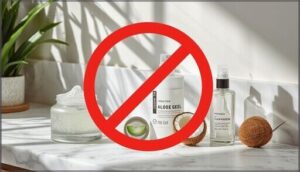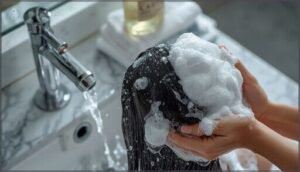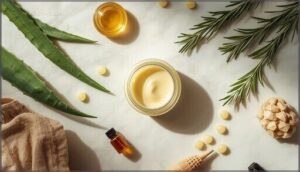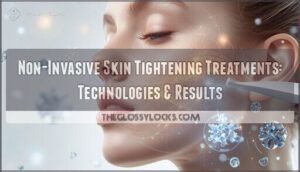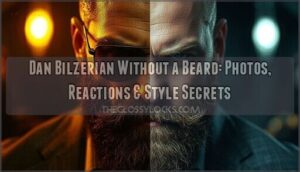This site is supported by our readers. We may earn a commission, at no cost to you, if you purchase through links.
You’ve likely heard the warnings from a well-meaning friend or anxious internet forum: hair gel causes baldness. That worry isn’t entirely baseless, but it’s also not quite accurate. Hair gel doesn’t directly damage your follicles or trigger permanent hair loss the way genetics or hormonal changes can.
However, certain ingredients in gel formulas can dry out your strands, trap buildup on your scalp, and create conditions where hair becomes brittle and breaks off. If you’re styling with gel regularly and noticing more shedding than usual, the culprit might be how you’re using it rather than the product itself.
Understanding what’s actually happening to your hair and scalp can help you style with confidence without sacrificing your hair’s health.
Table Of Contents
- Key Takeaways
- Does Hair Gel Cause Hair Loss?
- What Ingredients Are in Hair Gel?
- How Hair Gel Can Damage Your Hair
- How to Use Hair Gel Safely
- Best Shampoo and Cleansing Practices for Gel Users
- Better Alternatives to Traditional Hair Gel
- Maintaining Healthy Hair and Scalp While Styling
- Frequently Asked Questions (FAQs)
- Is It Ok to Use Hair Gel Every Day?
- What Can I Use Instead of Gel?
- Can I Use Vaseline as Hair Gel?
- Can You Use Coconut Oil as Hair Gel?
- Is Hair Wax Better Than Gel?
- Does Hair Gel Prevent Hair Growth?
- Can hair gel cause dandruff or flaking?
- Is hair gel safe for color-treated hair?
- How long does hair gel last once opened?
- Can children safely use hair gel products?
- Conclusion
Key Takeaways
- Hair gel doesn’t directly cause permanent hair loss like male pattern baldness, but certain ingredients (especially alcohol) and styling habits can dry out your hair, trigger scalp irritation, and lead to breakage that mimics thinning.
- Product buildup from not washing gel out thoroughly can clog your follicles and create inflammation, while tight hairstyles held with gel may cause traction alopecia—a reversible form of hair loss if you catch it early.
- You can safely use hair gel by applying it sparingly (avoiding your scalp), limiting use to 2-3 times weekly, washing thoroughly after each use, and switching to alcohol-free, water-based formulas that won’t strip your hair’s natural moisture.
- Gentler alternatives like pomades, mousses, aloe vera gel, or coconut oil provide hold and style without the harsh chemicals, and taking regular gel-free days gives your scalp time to recover and restore its natural oils.
Does Hair Gel Cause Hair Loss?
If you’ve been using hair gel and noticed more hair in the shower drain, it’s natural to wonder if the gel is to blame. The good news is that hair gel doesn’t directly cause permanent hair loss like male pattern baldness.
However, certain ingredients and styling habits can still affect your hair’s health in ways worth understanding.
No Direct Link to Permanent Hair Loss
You can breathe easy—scientific evidence shows no direct link between hair gel and permanent hair loss. Dermatological consensus confirms that gel only coats your hair follicles externally and doesn’t penetrate deep enough to cause lasting damage. Temporary shedding might happen from irritation, but health guidelines emphasize that preventing hair loss focuses on genetics and hormones, not your styling routine.
However, the buildup of gel can clog hair follicles, potentially leading to temporary issues.
Indirect Factors That May Contribute to Hair Loss
While gel won’t directly cause permanent hair loss, it can set the stage for problems. Product buildup clogs follicles, limiting growth. Alcohol dries your strands, making them snap easily. Tight styles held with gel pull on roots, risking traction alopecia. Harsh ingredients trigger scalp irritation and inflammation. Over time, these factors weaken hair and increase breakage—mimicking real hair loss. However, hair gel ingredients like PVP are generally safe.
What Ingredients Are in Hair Gel?
Hair gel isn’t just one ingredient—it’s a mix of chemicals that work together to hold your style in place. Some of these ingredients are harmless, while others can dry out your hair or irritate your scalp if you’re not careful.
Let’s break down what’s actually in that bottle and how each ingredient affects your hair.
Polyvinylpyrrolidone (PVP) and Vinyl Polymers
Most hair gels rely on polyvinylpyrrolidone (PVP) and vinyl copolymers to create that stiff, lasting hold through film formation around each strand. These polymers have solid regulatory oversight and thorough safety reviews confirm they won’t trigger hair loss.
Research even shows PVP aids follicle delivery in experimental treatments, proving it’s compatible with your scalp’s hair-growth structures rather than damaging them.
Alcohol and Its Drying Effects
While PVP stays harmless, alcohol prevalence in gels tells a different story—42.31% of products contain drying alcohols like ethanol and isopropyl. These strip your hair’s natural moisture, causing brittleness and frizz, especially if you have dry, curly, or color-treated hair types.
Thankfully, formulation evolution is shifting toward alcohol-free formulas as market trends reflect growing consumer awareness of hair damage from these harmful ingredients.
Parabens and Sulfates
Beyond alcohol, you’ll find parabens in roughly 99% of leave-on products and sulfates in most gels—both linked to scalp irritation and hair damage. Paraben exposure can trigger hormonal disruption, potentially interfering with hair growth cycles, while sulfate damage strips essential oils, causing protein loss and brittleness.
These harmful ingredients don’t directly cause hair loss, but they create conditions where irritating chemicals weaken your strands over time.
Silicones and Synthetic Fragrances
Many gels also contain dimethicone and other silicones that trap residue on your hair shaft, creating silicone buildup that leaves strands dull and prone to breakage. Synthetic fragrances introduce fragrance allergens and VOC exposure, triggering scalp irritation in up to 10% of users. Some compounds even cause endocrine disruption.
While these harmful ingredients don’t directly cause hair loss, they weaken hair over time.
How Hair Gel Can Damage Your Hair
Hair gel doesn’t directly cause permanent hair loss, but it can damage your hair in ways that lead to breakage and thinning. The ingredients and how you use the product matter more than most people realize.
Let’s look at four common ways hair gel can harm your hair and scalp.
Dryness and Brittleness From Alcohol-Based Formulas
Over 80% of commercial gels contain ethanol or isopropyl alcohol, which strips your hair’s lipid barrier and causes significant alcohol dehydration. This weakens tensile strength by up to 29%, leading to split ends and hair breakage.
Studies show 70% of users report consumer symptoms like dry hair and brittleness within weeks. Alcohol-based formulas accelerate hair dryness and structural hair damage, especially if you use gel daily.
Product Buildup and Clogged Follicles
When you don’t wash gel out properly, it traps sweat and oils that form a sticky layer over your hair follicles. This product buildup creates follicle obstruction risks by blocking the openings where hair grows.
That blocked environment encourages microbial growth and inflammation, which can trigger scalp health problems like folliculitis. Over time, this styling product residue can weaken your follicles and contribute to hair loss causes if you skip regular cleansing strategies.
Traction Alopecia From Tight Hairstyles
Using gel to hold tight braids, ponytails, or slicked-back styles can trigger traction alopecia—a condition affecting up to one-third of women who repeatedly stress their hair follicles.
High-risk styles include:
- Cornrows and tight braids that pull at your hairline
- Extensions and weaves combined with chemical relaxers
- Slicked ponytails held with strong-hold gel daily
- Buns and updos that strain your scalp edges
Early-stage traction alopecia is reversible if you switch to looser hairstyles promptly.
Scalp Irritation and Inflammation
Allergic contact dermatitis from gel ingredients like fragrances and preservatives triggers eczematous eruptions that affect 9% of patch-tested patients. Barrier disruption mechanisms—follicular plugging and transepidermal water loss—allow inflammatory cytokines to accumulate around follicles, worsening scalp health.
Clinical patterns of hair product buildup include itching, redness, and flaking, all documented hair loss causes when left untreated.
| Reaction Type | Scalp Symptoms |
|---|---|
| Allergic Contact Dermatitis | Itching, redness, swelling |
| Irritant Reaction | Burning, tightness, dryness |
| Follicular Plugging | Bumps, congestion, flaking |
| Chronic Inflammation | Thinning, shedding, sensitivity |
How to Use Hair Gel Safely
You don’t need to avoid hair gel completely, but you do need to use it the right way. Small changes in how you apply it and care for your hair afterward can prevent most of the damage we’ve talked about.
Here are four simple habits that’ll keep your hair healthy while still letting you get the hold and style you want.
Apply Sparingly and Avoid The Scalp
When styling, skip putting gel directly on your scalp—it can trigger product buildup that clogs follicles and throws off your moisture balance.
Instead, start with a small amount on your palms and work it through your hair from mid-shaft to ends. This technique minimizes irritation, protects follicle health, and keeps your hair looking great without the scalp issues that link hair gel and hair loss concerns.
Don’t Use Gel Every Day
Beyond smart application, usage frequency matters just as much. Daily gel use can dry out your hair and irritate your scalp—64% of everyday users report noticeable brittleness, and 32% see increased shedding. Your scalp needs recovery time.
Limit hair gel to 2-3 times weekly to reduce buildup, retain moisture, and cut damage risks. Consider these alternatives on off-days:
- Aloe vera gel for natural hold
- Light pomades for softer texture
- Flaxseed gel to minimize buildup
- Coconut oil for gentle styling
- Sea salt spray for volume
This approach protects against hair loss while keeping your hair styling routine flexible and your hair care on track.
Wash Hair Thoroughly After Each Use
The most common mistake gel users make is skipping proper hair cleansing. Up to 60% experience product residue that clogs follicles and triggers scalp irritation. Thorough shampooing, ideally after each use, is necessary to prevent hair product buildup.
Proper hair cleansing protects your scalp health and prevents inflammation that increases shedding.
| Cleansing Method | Buildup Prevention Effectiveness |
|---|---|
| Regular shampoo | Moderate |
| Clarifying shampoo | High (70%+ removal rate) |
| Sulfate-free shampoo | Good for gentle cleansing |
Choose Alcohol-Free, Water-Based Formulas
Once your hair is clean, the next smart move is switching to better formulas. Water-based gels held over 42% of the market in 2024 because they work without the damage. Alcohol-free formulas protect scalp health by maintaining hydration instead of stripping moisture.
Salon recommendations increasingly favor these ingredient safety winners—they prevent dryness, skip harsh chemicals, and follow current market trends toward gentler styling.
Best Shampoo and Cleansing Practices for Gel Users
If you use hair gel regularly, washing your hair properly becomes even more important. The right shampoo and cleansing routine can prevent buildup, protect your scalp, and keep your hair healthy.
Here’s what you need to know about cleansing when you’re a gel user.
Use Sulfate-Free Shampoos
When gel becomes a regular part of your routine, switching to a sulfate-free shampoo is one of the smartest moves for scalp health and moisture retention. Sulfates strip away natural oils, worsening dryness from alcohol-based gels.
Gentle cleansing with clean beauty formulas preserves hair health while removing product buildup.
These environmentally conscious hair care tips help prevent irritation without the harsh lather—your hair stays healthier, stronger, and less prone to damage.
Deep Cleanse to Remove Buildup
If product buildup is weighing down your hair, clarifying shampoos and micellar technology offer targeted solutions. These deep cleansing formulas break down stubborn residue that regular sulfate-free shampoo might miss.
Chelating agents help tackle mineral deposits from hard water, improving shine and reducing irritation.
Use clarifying treatments once weekly or biweekly—overuse strips protective oils. Scalp exfoliators paired with proper product buildup removal keep your follicles breathing freely.
Condition Hair to Restore Moisture
After cleansing away gel buildup, deep conditioning becomes your hair’s lifeline. Look for conditioner ingredients like proteins and humectants that target hair porosity, improving hydration retention by up to 30%.
Individual factors—texture, chemical history, damage level—determine which formulas prevent hair loss and restore hair health best.
Weekly treatments strengthen strands, reduce hair damage, and maintain the hair hydration your styling routine constantly challenges.
Better Alternatives to Traditional Hair Gel
If you’re worried about the downsides of traditional gel, you don’t have to give up styling altogether. There are plenty of gentler alternatives that give you hold, texture, and shine without the harsh ingredients or buildup.
Here are some options worth trying.
Pomades and Styling Creams
Looking for a gentler way to style your hair without the harsh effects of traditional gel? Pomade and styling cream offer flexible hold with fewer drawbacks. Here’s why they’re worth trying:
- Pomade ingredients like lighter oils nourish hair without heavy buildup when you choose water-soluble formulas
- Cream benefits include conditioning agents that keep hair soft while styling
- Safe usage means avoiding direct scalp application and practicing buildup prevention through proper cleansing
Mousses for Volume and Hold
Want fuller hair without the crunch? Mousse vs. gel shows a clear winner for volume performance. Volumeboosting mousse delivers flexible hold and hair volume using lightweight mousse formulas that won’t weigh you down.
Ingredient innovations now include heat protectants and nourishing botanicals.
Consumer trends confirm styling versatility—this styling product works on damp or dry hair, making it perfect for everyday use without buildup concerns.
Natural Options Like Aloe Vera Gel
Aloe vera gel stands out as a scalp health champion among hair gel alternatives. Clinical trials show it reduces dandruff by nearly 60% and calms inflammation that contributes to hair loss. You’ll get light hold without the drying alcohols found in traditional products.
Usage considerations? Apply sparingly to damp hair. Aloe benefits extend beyond styling—it actually improves hair quality and aids in preventing hair damage while maintaining hair health naturally.
Coconut Oil for Light Styling
Coconut oil offers another gentle styling option with proven hair health perks. Studies show it cuts breakage by over 40% while fighting scalp bacteria that worsen hair loss. You’ll get shine and frizz control without harsh chemicals.
But there’s a catch—it works best for dry or curly hair. Fine hair? You might end up looking greasy. Always wash it out completely to prevent clogged follicles.
Maintaining Healthy Hair and Scalp While Styling
Even if you choose safer styling products, how you care for your hair between uses matters just as much. Your scalp and hair need consistent attention to stay healthy under regular styling.
Here are a few simple habits that’ll keep your hair strong and your scalp happy while you style.
Give Your Hair Gel-Free Days
Just like your skin needs breaks from makeup, your scalp craves recovery time from hair gel. Taking regular gel-free days promotes scalp recovery and restores sebum balance, which reduces breakage by up to 40%.
Your scalp needs regular breaks from hair gel to recover, restore natural oils, and reduce breakage by up to 40%
These breaks prevent product buildup that clogs follicles and causes potential hair damage. While hair gel alternatives exist, giving your hair rest days improves hair elasticity and lowers your risk of hair loss from styling stress.
Use Hair Masks and Deep Conditioning Treatments
Beyond taking gel-free days, you can repair hair damage with weekly hair masks and deep conditioning treatments. These products restore moisture and strengthen strands with nourishing mask ingredients like proteins and ceramides.
Treatment frequency depends on your porosity needs—high-porosity hair benefits from twice-weekly sessions, while low-porosity hair thrives with biweekly applications. Seasonal changes may require adjustments to maintain hair and scalp health throughout the year.
Avoid Brushing Wet Hair
You’re protecting your hair with masks and gel-free days, but one common mistake can undo that work—brushing wet hair. Water weakens hair strands by up to 30%, triggering cuticle swelling risk and increased hair shedding. Wet hair strength drops considerably, making hair breakage more likely.
For safer brushing practices that minimize wet damage, let your hair air-dry partially before detangling hair type appropriately, or use a wide-tooth comb with conditioner to protect hair cuticles.
Monitor for Signs of Scalp Irritation
Watch your scalp closely for early warning signs of irritation symptoms that can lead to potential hair damage. Ingredient reactions don’t always appear immediately, so tracking symptom patterns helps you catch problems before they worsen. Pay attention to:
- Redness, itching, or burning that worsens after gel application
- Flaking, scaling, or unusual dryness despite regular washing
- Small bumps or tender spots along your hairline
- Persistent symptoms lasting beyond two weeks
If scalp irritation continues or you notice increased hair loss despite product changes, medical evaluation and testing frequency reviews with a dermatologist can identify specific allergens affecting your hair and scalp health.
Frequently Asked Questions (FAQs)
Is It Ok to Use Hair Gel Every Day?
You can use hair gel daily, but it’s not ideal.
A 2019 study found men applying gel every day face higher scalp issues—buildup, dryness, and irritation increase considerably without proper cleansing routines.
What Can I Use Instead of Gel?
You can use pomades and styling creams for flexible hold, mousses for volume, aloe vera gel for hydration, or coconut oil for light styling.
These natural alternatives to hair gel avoid harsh chemicals.
Can I Use Vaseline as Hair Gel?
You can use Vaseline for hair styling, but it creates buildup removal challenges and risks scalp folliculitis.
The occlusive barrier traps dirt, reducing hair quality.
Safe usage means tiny amounts on ends only, avoiding roots entirely.
Can You Use Coconut Oil as Hair Gel?
Coconut oil can replace hair gel for light hold and frizz control, though it won’t deliver the firm grip of traditional gels.
Its moisturizing properties suit dry hair types but may weigh down fine strands if overused.
Is Hair Wax Better Than Gel?
Hair wax offers flexibility and less dryness than gel, making it gentler on your scalp. However, both require proper cleansing to prevent buildup.
Your choice depends on hold preferences and styling needs.
Does Hair Gel Prevent Hair Growth?
Good news—gel won’t genuinely ground growth to a halt. Studies show gel penetration depth doesn’t reach follicles where hair health starts, meaning follicle function disruption and follicle growth inhibition aren’t genuine concerns here.
Can hair gel cause dandruff or flaking?
Yes, hair gel can cause flaking. Alcohol-induced dryness, product buildup, and scalp irritation disrupt scalp health. Poor hygiene practices trap residue, creating fungal aggravation that worsens dandruff and scalp conditions through persistent hair product buildup.
Is hair gel safe for color-treated hair?
Color-safe gels protect your investment, but ingredient sensitivities matter. Professional guidance suggests avoiding sulfates and alcohol—they accelerate color fading and hair damage.
Choose silicone-based, color-safe hair products to minimize adverse effects on color-treated hair health.
How long does hair gel last once opened?
Once opened, most hair gels remain effective for 12 months—look for the PAO symbol on packaging.
Product safety depends on proper storage, avoiding moisture and heat that accelerate gel degradation and spoilage.
Can children safely use hair gel products?
Children can safely use hair gel if you choose pediatric formulas free from harsh chemicals. Look for alcohol-free, hypoallergenic options with natural ingredients to minimize scalp reactions and gel ingestion risks while protecting hair and scalp health.
Conclusion
A patient once came in convinced his thinning hair was from years of gel use. After examination, it was genetic. But his scalp was irritated from buildup, making things worse.
The takeaway? Hair gel doesn’t cause permanent hair loss, but poor habits around it can weaken strands and inflame your scalp. Use it wisely, wash thoroughly, and give your hair breaks. Your styling routine should work with your hair’s biology, not against it.
- https://ottawabarber.ca/blog/does-hair-gel-damage-your-hair
- https://wimpoleclinic.com/blog/does-hair-gel-cause-hair-loss/
- https://www.zestige.co.uk/is-hair-gel-bad-for-your-hair/
- https://www.upnorthnaturals.ca/blogs/up-north-blog/what-are-the-side-effects-of-hair-gel-on-the-scalp
- https://www.hshairclinic.co.uk/news/can-hair-gel-cause-hair-loss





